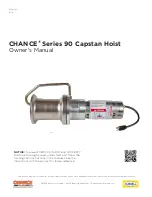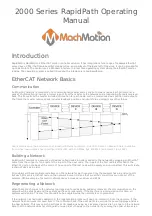
15
©2018 Hubbell Incorporated | Chance
®
Capstan Hoist Operating Instructions
Operating the Hoist (cont.)
Continued from previous page.
It is important to use the proper number of rope turns. Many variables (such as the load to be raised,
amount of mechanical advantage in the tackle, size, and age of rope) affect the number of turns.
The final determination is made by feel. “Feel” is the amount of force required to keep the rope just
tight enough around the capstan to raise or lower a load. With the proper number of wraps, a slight
(approximately 20-lb.) pull should raise or lower a load. Adding wraps decreases the amount of pull
required to control the load. Removing wraps increases the amount of pull required.
NOTE: Before learning this technique, there is a natural tendency either to pull harder than necessary
or, conversely, to use an excessive number of turns. For most applications, 3 to 4 turns are adequate.
The best method for lowering a load is with the hoist motor running. Although the capstan turns in
a direction opposite that of the rope when doing so, rope action on the capstan is smoother than
merely allowing the rope to slip on a stationary capstan.
If, however, starting the hoist before lowering a load could raise the load and thereby cause an unsafe
condition, lower the load by just slipping the rope without rotating the capstan. When the load is in
the clear, rotate the capstan by running the hoist motor for smoother rope action.
Overhead loads can fall. Will cause damage to equipment, severe injury, or death. Do not allow
people to stand under or near the load. Keep rope securely on capstan drum and under control by
the operator. Do not remove wraps of rope from the drum while supporting a load. Do not allow
the rope to overwrap itself or to ride up over the end of the drum flange.
!
DANGER
Performing the Lift
RECOMMENDATION: Perform a short test lift by raising the load a short distance off the ground, then
slowly lower it back down. This allows the operator to fine-tune and test the Capstan system, such
as turns of rope on the capstan drum and proper alignment of the load line before the actual lift is
performed.
Lifting the load or pulling cable is a simple matter of starting the hoist by stepping on the foot
control and applying pull to the fall line. Continue a steady pull, hand over hand, to complete the lift.
When the load is near the final point, slow down on the fall line pull to ease the load into position.
With minimal practice, the operator can place the load within a fraction of an inch. Once the load is in
place, lifting your foot from the foot control stops the hoist.
To Lower a Load
The CHANCE
®
hoist is equipped with an anti-reversing brake which prevents the drum from turning
backwards. This allows the load to be held in position by holding the fall line. If the load needs to be
lowered, simply allow the rope to slip back around the drum slowly, allowing the operator to lower
the load safely and in full control.
Ensure the load is clear of obstructions or energized lines prior to starting capstan.
NOTE: Load will be raised slightly before being lowered once the capstan starts turning.
Do not operate hoist without the appropriate foot control switch. Loss of control, damage, injury,
or death could result.
!
DANGER
















































